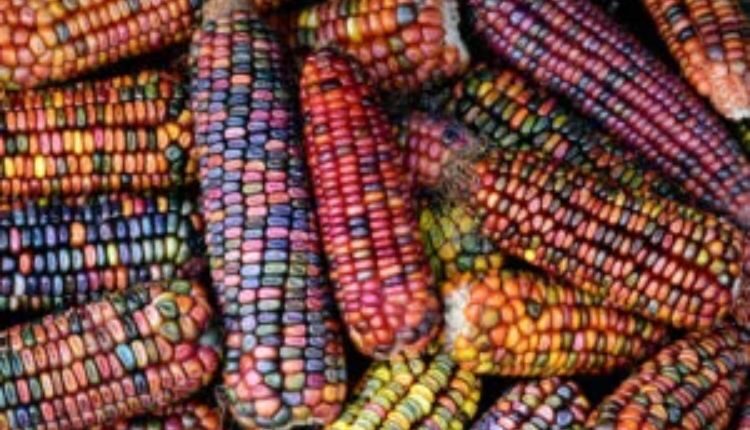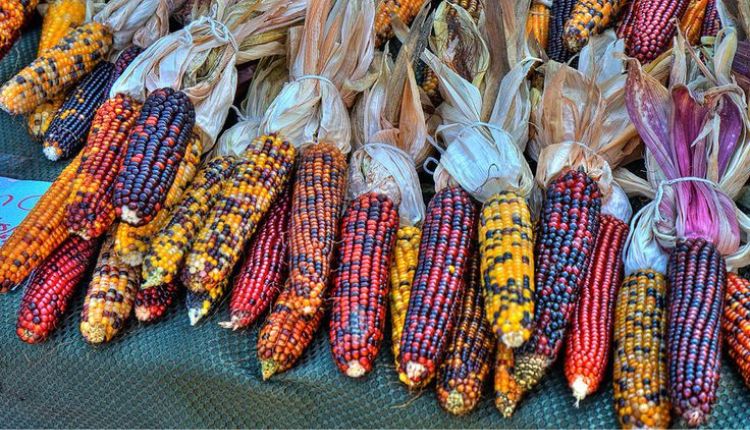Coloured Corn Cultivation : Check the colourful varieties of maize in India, cultivated mainly by North East India
Farmers get benefits and income from Coloured Corn Cultivation
Look at the image attached here.

These are not photoshop images or innovative version of corn. On the first instance, it looks like we have coloured the yellow corns. But that is also not the case. These are very real varieties of corn grown in India, popularly known as coloured corns.
Maize, commonly know as corn is considered super food today. In India, Maize is grown throughout the year. It is predominantly a Kharif crop with 85 percent of the area under cultivation during the season. Maize is the third most important cereal crop in India after rice and wheat. It accounts for around 10 percent of total food grain production in the country. Among Indian states Madhya Pradesh and Karnataka have highest area under maize (15% each) followed by Maharashtra (10%), Rajasthan (9%), Uttar Pradesh (8%) and others. After Karnataka and Madhya Pradesh Bihar is the highest maize producer. In India, maize is traditionally grown in monsoon (Kharif) season, which is accompanied by high temperature (<35° C) and rainfall. However, with time and technology, winter cultivation of maize/corn has emerged as a viable alternative.

Maize/Corn varieties
There are many varieties of corn. The five main ones are Sweet Corn, Flour Corn, Popcorn, Field Corn and Flint Corn. Other categories include Waxy Corn, Slender Corn, Ornamental Corn, and Pod Corn. The coloured corns are also called Flint corn.
In India, we just need to travel to the seven sisters and find this treasure. People in the North-east have been actively cultivating and consuming these lesser-known varieties of coloured corn from a long time. It can be majorly found in Mizoram. These are really popular with the locals. It is used in daily cooking and also in traditional desserts known as ‘Mim Ban’. Although, some of the varieties are also cultivated in Karnataka by the tribal communities.

What are Coloured Corns?
You have seen yellow corn, used it, eaten it and enjoyed thoroughly. Now let’s try the coloured corns. They are available in multicolours like red, blue, purple and black. Believe it or not, but they are cultivated for more than 3000 years and have been a major part of our food system in ancient times. Today, they are grown extensively in Mizoram in India and are locally known as Mim Ban, which means sticky corn. The locals of Mizoram have been cultivating these varieties for years. They have a sweet and nutty flavour.

What gives colour to the corn?
This seems natural but has a scientific angle too. No doubt, there are special content in these coloured corns. Specially the presence of high phenolic content and anthocyanins is responsible for their distinct colour. They are water-soluble plant pigments responsible for the blue, purple, and red colour of many plant tissues.
Maize is divided into three categories on the basis of colours. Purple corn comes in the first category, blue corn in the second category and red corn in the third category. Anthocyanin is mainly present in the thick pericarp of purple maize. In blue maize, pericarp is thin, so the anthocyanin pigment is present in the aleurone layer. In red maize, anthocyanin pigment is present in different areas giving it different shades. In light red coloured maize, anthocyanin in present in pericarp, in magenta coloured maize, anthocyanin pigment is present in pericarp as well as aleurone layer.
Although, light, medium and dark shades can be found in all types of complexions. These shades depend on the type of pigment, their quantity and their position in the granules. The beautiful colour combinations and patterns are a result of cross pollination with plants of solid coloured cultivars as well. The pattern on the corn is called calico-patterned ears with a patchwork of white, blue, red, gold and yellow kernels.

Characteristics of coloured corn
Most corn comes in just yellow or white, but Indian corn is much more variable. Some varieties are a single colour in shades of white, red, blue and black, but most are multi-coloured. Some of its characteristics are :
- Indian or flint corn has very low water content.
- It has a very hard outer layer on the kernels
- The hard outer layer gives rise to the common name flint, as in the stone.
- This type of corn grows the same as regular sweet or field corn.
- There are cultivars that produce regular-sized ears as well as some that have small, 2-4 inch ears.

How to grow coloured corn in India ?
- Indian corn is easy to grow in your backyard.
- Yellow corn and coloured corn are grown with the same process.
- Only difference is, coloured corn can get multiple colours if different colours are grown near each other through cross pollination.
- Corn is pollinated by the usual pollinating insects such as bees.
- It can also get pollinated via the wind blowing the pollen onto neighbouring plants.
- All types of corns will cross-pollinate with each other .
- To stop cross pollination, avoid planting cultivars too close together.
- So plant each type of corn at least 300 yards apart to avoid cross-pollination.
- Prepare your soil by turning your soil 6 to 12 inches deep.
- You can plant your seeds in either rows or hills.
- If you are planting them in rows, plant one seed every 4 inches in rows that are 18 to 24 inches apart.
- In case you don’t have much space/field area, separate the varieties based on time of pollination.
- On hills, plant 3 to 4 seeds per hill, spaced 12 inches apart.
- When your plants are 4 inches tall, thin them, remove any sickly or deformed plants.
- You can transplant healthy seedlings into any empty spaces on your hills.
- Make sure to weed aggressively so that the corn does not have to compete with the weeds for nutrients.
- If you want multicoloured corn, plant in a block or multiple rows so the corn is easily pollinated by the wind.
- Single rows result in poor pollination, and the ears will not fill with kernels.
- Provide a little fertilizer, and water well.
- The ears used for ornamental purposes should remain on the stalks until the husks are no longer green.
- They should be cured in a warm, dry area for about a week.
Precautions
- As soon as the outer husk turns brown, Indian corn is ripe and ready for harvest.
- Removing the ears from the stalks is easy.
- To dry your corn, peel the husk all the way back from the ear, exposing all of the kernels.
- Tie a string around the base of the husk and hang your corn in a dry, dark place.
- Make sure your corn is not exposed to the sun while it is drying.
- Sunlight will fade the beautiful colours.

Can we eat coloured corn ?
Yes, you can eat coloured corn. It is roasted, used in desserts and stews. But it is not naturally sweet like most other corn varieties. Instead, it is quite starchy and is typically used to make flour, cornmeal or popped as popcorn.
Health benefits of coloured corn
- These beautiful coloured corn are very good for your eyes (eyesight).
- They even improve your nervous system.
- They help in keeping blood pressure in control.
- They can even enhance your kidney health.
- All coloured corns are rich in antioxidants.
- When it comes to health, we prefer to eat proteins than carbohydrates or fats. Coloured corns, specially the red ones have 20 percent more proteins and 45 percent more antioxidants.
- Coloured corns have CG3, the most powerful antioxidants, which have anti ageing properties.
- They can even be used as a natural colouring agent.
- They can be used to make edible colour for food and beverage.
- Some of these varieties also act as anti inflammatory substances.
- During an experiment, it is even found helpful in decreasing the carcinogenic cells in rats.
- Last but not the least, these coloured corns add colour to your plate.

Coloured corn used as ornaments and in decoration
Looking at the beauty of the corn variety, people even want to use them as ornaments or decorative pieces at their homes. Once the kernels are dry, test them by pushing your finger nails into it. If it is hard enough to not pierce your nails in the kernels, your corn is dry and ready to use for decoration. They can then be displayed or stored for many weeks or months at room temperature. To give good look, good feel and to make it sustain longer, brush a coat of varnish on the corns.
Contact us: If farmers want to share information or experiences related to farming with us, then they can do this by calling us on the phone number 9599273766 or by writing an email to [email protected] or by sending your recording. Through Kisan of India, we will convey your message to the people, because we believe that if the farmers are advanced then the country is happy.



